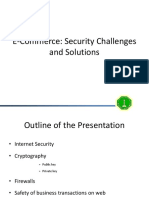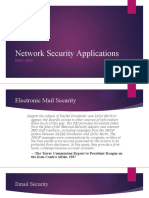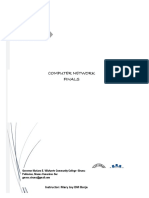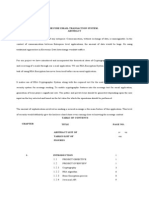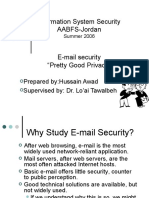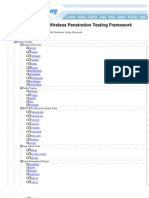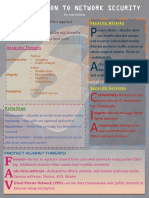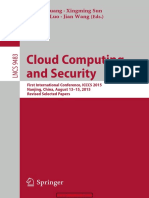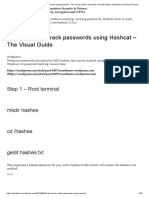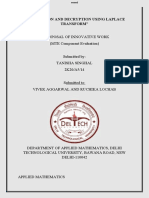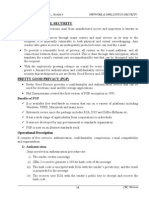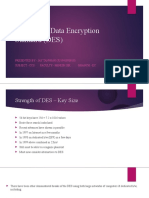E-Commerce: Security Challenges and Solutions
Dr. Khalid Al-Tawil
College of Computer Sciences & Engineering
King Fahd University of Petroleum and Minerals
�Outline of the Presentation
Internet Security
Cryptography
Firewalls
E-Commerce Challenges
E-Commerce Security
Global & Local Issues
�Challenges to Security
Internet was never designed with security in mind.
Many companies fail to take adequate measures to protect their internal systems from attacks. Security precautions are expensive {firewalls, secure web servers, encryption mechanisms}. Security is difficult to achieve.
�Introduction
Two Major Developments During the Past Decade: 1. Widespread Computerization 2. Growing Networking and Internetworking The Internet Need for Automated Tools for Protecting Files and Other Information. Network and Internetwork Security refer to measures needed to protect data during its transmission from one computer to another in a network or from one network to another in an internetwork.
�Continue
Network security is complex. Some reasons are: Requirements for security services are:
Confidentiality Authentication Integrity
Key Management is difficult. Creation, Distribution, and Protection of Key information calls for the need for secure services, the same services that they are trying to provide.
�Cyberterrorists
In 1996 the Pentagon revealed that in the
previous year it had suffered some two
hundred fifty thousand attempted intrusions
into its computers by hackers on the Internet Nearly a hundred sixty of the break-ins were successful.
�Continue
Security Attacks:
Interruption Interceptor Modification Fabrication Viruses
Passive Attacks: Interception(confidentiality)
Release of message contents Traffic Analysis
�Continue
Active Attacks:
Interruption (availability)
Modification (integrity)
Fabrication (integrity)
�Security Threats
Unauthorized access Loss of message confidentiality or integrity User Identification Access Control Players:
User community Network Administration Introducers/Haclers
The bigger the system, the safer it is
MVS mainframe users (5%) UNIX users (25%) Desktop users (50%)
�Introduction to Security Risks
Hackers and crackers
The Internet: open
$$
Your network: data! virus
�The Main Security Risks
Data being stolen
Electronic mail can be intercepted and read Customers credit card numbers may be read
Login/password and other access information stolen Operating system shutdown Filesystem corruption User login information can be captured
�Viruses
Unauthorized software being run
Games
Widely distributed software
Shareware Freeware Distributed software
�Possible Security Holes
Passwords
Transmitted in plain text Could be temporarily stored in unsafe files Could be easy to guess
Directory structure
Access to system directories could be a threat
In the operating system software
Some operating system software is not designed for secure operation Security system manager should subscribe to
comp.security.unix comp.security.misc alt.security
�Security Strategies
Use a separate host
Permanently connected to the Internet, not to your network. Users dial in to a separate host and get onto the Internet through it.
Passwords
Most important protection Should be at least eight characters long Use a mixture of alpha and numeric Should not be able to be found in dictionary
should not be associated with you!
Change regularly
�Continue
Every transaction generates record in a security log file
Might slow traffic and host computer Keeps a permanent record on how your machine is accessed
Tracks
Generates alarms when someone attempts to access secure area Separate the directories that anonymous users can access Enforce user account logon for internal users Read web server logs regularly
�Cryptography
The Science of Secret writing.
Encryption: Data is transformed into unreadable form. Decryption: Transforming the encrypted data back into its original form. Encryption Plaintext Ciphertext
Decryption
Types of Cipher
Transposition Substitution
�Types of Cryptosystems
Conventional Cryptosystems
Secret key Cryptosystems. One secret key for Encryption and Decryption.
Example: DES
Public key cryptosystems
Two Keys for each user
Public key (encryptions)
Private key (decryptions)
Example: RSA
�Types of Cryptosystems (Secret Key)
Both the encryption and decryption keys are kept secret.
Example: To encrypt, map each letter into the third letter forward in the alphabet order; To decrypt, map each letter into the third letter back.
Problems with Secret Key Cryptosystems:
Key transfer Too many keys
�Secret Key Cryptosystems (DES)
Data Encryption Standard (1977) Started with an IBM Project called LUCIFER (1971) DES key length: 56-bits Uses 16 iterations with
Transportation Substitution XOR operations
DES Criticism
Key length Design of S-Boxes in hidden
Future
Multiple DES IDEA ( International Data Encryption Algorithm)
�Types of Cryptosystems (Public Key)
Only the decryption key is kept secret. The encryption key is made public. Each user has two keys, one secret and one public. Public keys are maintained in a public directory. To send a message M to user B, encrypt using the public key of B. B decrypts using his secret key. Signing Messages For a user Y to send a signed message M to user X.
Y encrypts M using his secret key. X decrypts the message using Ys public key.
�Public Key
A M
encryption
Public key of B
B
Private Key of B
Ciphertext C
Insecure communications or storage. Territory of the Intruder
C
decryption
A wants to send M in a secure manner to B
�Firewalls
A firewall is a barrier placed between the private network and the outside world. All incoming and outgoing traffic must pass through it. Can be used to separate address domains. Control network traffic. Cost: ranges from no-cost (available on the Internet) to $ 100,000 hardware/software system. Types:
Router-Based Host Based Circuit Gateways
�Firewall
Filter Inside
Gateway(s)
Filter Outside
Schematic of a firewall
�Firewall Types (Router-Based)
Use programmable routers Control traffic based on IP addresses or port information. Examples:
Bastion Configuration Diode Configuration
To improve security: Never allow in-band programming via Telnet to a firewall router. Firewall routers should never advertise their presence to outside users.
�Bastion Firewalls
External Router Host PC Secured Router
Internet
Private Internal Network
�Firewall Types (Host-Based)
Use a computer instead of router.
More flexible (ability to log all activities) Works at application level Use specialized software applications and service proxies. Need specialized programs, only important services will be supported.
�Continue
Example: Proxies and Host-Based Firewalls
Proxies and Host-Based Firewalls Internal Network Filtering Router (Optimal)
Host running only proxy versions of FTP,Telnet and so on.
Internet
�Electronic Mail Security
E-mail is the most widely used application in the Internet.
Who wants to read your mail ?
Business competitors
Reporters,Criminals Friends and Family
Two approaches are used:
PGP: Pretty Good Privacy PEM: Privacy-Enhanced Mail
�E-mail Security (PGP)
Available free worldwide in versions running on:
DOS/Windows
Unix
Macintosh
Based on:
RSA
IDEA MD5
�Continue
Where to get PGP
Free from FTP site on the Internet Licensed version from ViaCrypt in USA
Example:
pgp -kg ID-A pgp esa m.txt ID-B pgp message Signature Encryption Decryption
�E-mail Security (PEM)
A draft Internet Standard (1993).
Used with SMTP.
Implemented at application layer.
Provides:
Disclosure protection Originator authenticity Message integrity
�Summary of PGP Services
Function
Message encryption key
Algorithms used
IDEA, RSA
Description
A message is encrypted using IDEA . The session is encrypted using RSA recipients public key. A hash code of a message is created using MD5. This is encrypted using RSA with the senders private key.
Digital signature
RSA, MD5
Compression
E-mail compatibility
ZIP
Radix 64 conversion
A message may be compressed using ZIP.
To provide transparency for e-mail applications.
�Summary of PEM Services
Function
Message encryption
Algorithms used
DES
Description
A message is encrypted using DES-CBC. The session key is encrypted using RSA with the recipients public key. A hash code of a message is created using MD2 or MD5. This is encrypted using RSA with the senders private key. To provide transparency for e-mail applications.
Authentication and Digital signature(asymmetric encryption) E-mail compatibility
RSA with MD2 or MD5
Radix 64 conversion
�E-Commerce: Challenges
Trusting others electronically
E-Commerce infrastructure
Security threats the real threats and the perceptions Network connectivity and availability issues
Better architecture and planning
Global economy issues
Flexible solutions
�E-Commerce: Challenges
Trusting others electronically
Authentication
Handling of private information
Message integrity
Digital signatures and non-repudiation
Access to timely information
�E-Commerce: Challenges Trusting Others
Trusting the medium
Am I connected to the correct web site? Is the right person using the other computer? Did the appropriate party send the last email? Did the last message get there in time, correctly?
�E-Commerce: Solutions Trusting Others
Public-Key Infrastructure (PKI)
Distribute key pairs to all interested entities
Certify public keys in a trusted fashion
The Certificate Authority
Secure protocols between entities Digital Signatures, trusted records and non-repudiation
�E-Commerce: Challenges Security Threats
Authentication problems
Impersonation attacks
Privacy problems
Hacking and similar attacks
Integrity problems
Repudiation problems
�Secure Protocols
How to communicate securely:
SSL the web security protocols IPSEC the IP layer security protocol SMIME the email security protocol SET credit card transaction security protocol Others
�Secure Sockets Layer (SSL)
Platform and Application Independent
Operates between application and transport layers Web Applications
HTTP NNTP FTP Telnet Etc. Future Apps
SSL
TCP/IP
�Secure Sockets Layer (SSL)
Negotiates and employs essential functions
for secure transactions
Mutual Authentication
Data Encryption
Data Integrity
As simple and transparent as possible
�SSL 3.0 Layers
Record Layer
Fragmentation, Compression, Message Authentication (MAC), Encryption
Alert Layer
close errors, message sequence errors, bad MACs, certificate errors
�Why did SSL Succeed
Simple solution with many applications ebusiness and e-commerce
No change in operating systems or network stacks very low overhead for deployment Focuses on the weak link the open wire, not trying to do everything to everyone Solution to authentication, privacy and integrity problems and avoiding classes of attacks
�SSL and Security Attacks or how to design secure protocols
Man in the middle
Spoofing attacks Replay attacks and transaction freshness Negotiation attacks Snooping attacks
�S-HTTP
Secured HTTP (S-HTTP)
Security on application layer Protection mechanism:
Digital Signature Message authentication Message encryption
Support private & public key cryptograph Enhanced HTTP data exchange
�S-HTTP vs. SSL
User Interface
Application Layer
S-HTTP HTTP, SMTP, FTP, Telnet, Other Apps.
SSL Transport Layer Internet Layer Network Layer
PCT
SET
Transport Control Protocol Internet Protocol (IP) Network
�SSL
Operate on transport layer Encryption only for integrity and confidentiality Support HTTP, Telnet, FTP, Gopher, etc.
S-HTTP
Operate on application layer Encryption and digital signature Work only with (HTTP)
Application independent
Provide P-to-P protection DES, RSA, RC-2 and RC-4 with different size of keys One step security
Application dependant
More secure than SSL at end point even after data transfer
No particular cryptographic
system Multiple times encryption
�Secured Electronic Transactions (SET)
Developed by VISA & MasterCard
SET Specifications:
Digital Certificates (Identification) Public Key (Privacy)
On-Line Shopping Steps:
C.H. Obtain Digital Wallets C.H. Obtain Digital Certificates C.H. & Merchants conduct Shopping Dialog Authentication & Settlement Process
�E-Commerce: Challenges Connectivity and availability
Issues with variable response during peak time
Guaranteed delivery, response and receipts Spoofing attacks
Attract users to other sites
Denial of service attacks
Prevent users from accessing the site
Tracking and monitoring networks
�E-Commerce: Challenges Global Economy
Variable connectivity levels and cost
Variable economies and cultures Taxation and intellectual property issues
Interoperability between different economies
�Existing Technologies Overview
Networking Products
Firewalls Remote access and Virtual Private Networks (VPNs) Encryption technologies Public Key Infrastructure Scanners, monitors and filters Web products and applications
�Encryption Technologies
Hardware assist to speed up performance
Encryption at different network layers; Layer2
through application layers
Provide both public-key systems as well as
bulk encryption using symmetric-key methods
Stored data encryption and recovery
�PKI
A set of technologies and procedures to
enable electronic authentication Uses public key cryptography and digital certificates Certificate life-cycle management
�PKI Architecture
Switched segment
Internet
FIGURE 1: PKI SYSTEM BLO CK DI AGRAM [Numeric labels correspond to list above]
DMZ ( DM Zone)
1
Internet Applications
Cer tificate Request Web Ser ver s
3
Cer tificate Directory
RA Zone RAO Zone
Status Query 5 6
RAO Stations (Operators at Consoles)
Certificate Request 4
RA Stations
RA DB
Store new certificate, CRL Update
CA Zone
7 8 CA DB
CA Stations
�Scanners, Monitors and Filters
Too much network traffic without designed policies
Scanners understand the network configurations Monitors provide intrusion detection based on preset patterns Filters prevent unwanted traffic based of type, for example virus detection
�Web Products
Secure web servers SSL enabled
Application servers generally lacking any
security support
A number of toolkits to enable applications to utilize security functions Integration into existing (legacy) infrastructure is difficult
�What is Missing??
Solid architecture practices
Policy-based proactive security management Quantitative risk management measures especially regarding e-commerce or ebusiness implementations
�E-Commerce Architecture
Support for peak access
Replication and mirroring, round robin
schemes avoid denial of service
Security of web pages through certificates
and network architecture to avoid spoofing
attacks
�Proactive Security Design
Decide on what is permissible and what is
right Design a central policy, and enforce it everywhere Enforce user identities and the use of
credentials to access resources
Monitor the network to evaluate the results
�PKI and E-Commerce
Identity-based certificate to identify all users
of an application Determine rightful users for resources Role-based certificates to identify the authorization rights for a user
�Architectures for E-Commerce
Central Policy Node A P P L I C A T I O N Enforcement Nodes Perimeter
PKI based policy decisions To other networks
PKI based user access
�Existing EPS:
Electronic Cash
Imitates Paper Cash Examples: CyberCash, CyberCoin, DigiCash and Virtual Smart Cards
Electronic Checking
Same as Paper Checks Use Automated Clearing House (ACH) Examples: CheckFree, NetCheque and NetChex Not well developed as E-Cash or Credit Card
Credit Cards
Not used in Internet until SET become Internet Standard
�E-Commerce: Are We Ready?
Infrastructure?
Security? Policies & legal issues? Arabic content?
�E-Commerce: Future
Was expected to reach 37,500 (million US $)
in 2002. It reached 50,000 (million US $) in
1998
Expected to reach 8 million company in 2000.
(40% of total commerce)
Arab word, about 100 million US $
�Continue
B-to-B E-Commerce will grow faster than Bto-C E-Commerce E-business is expected to grow faster in: Europe 118% Annual growth rate worldwide 86% * Number of companies is expected to reach 8 million by 2002 **
* Study by Nortel Networks (Financial Times 28/1/2000) ** British Telecom

